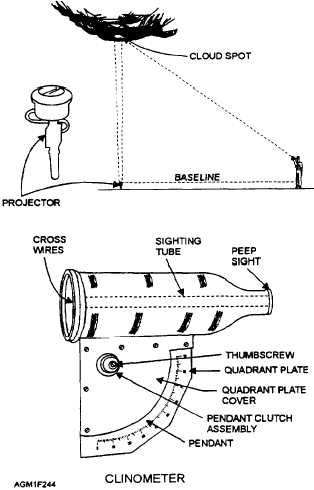shipboard clinometer, used both aboard ship and
ashore. The ML-l19 clinometer is shown in figure
2-44. It is hand-held, whereas the shipboard clinometer
is mounted on a bracket and supplied with a
weatherproof cover; operation is similar.
Operation
To operate the clinometer, loosen the clutch screw
to allow the elevation scale to swing freely. After
sighting the light spot on the cloud base, bring the cross
hairs to bear on the spot. Then, with the cross hairs on
the spot, tighten the clutch screw, and read the elevation
angle from the scale to the nearest whole degree. Cloud
height is calculated by multiplying the baseline distance
by the tangent of the elevation angle. Normally, a
minimum of three readings are used to determine an
average. Aboard ship, add the height of the clinometer
above the waterline to the calculated distance. Where
established premeasured baselines are used, tables for
converting measured elevation angle to cloud height
may have been previously calculated and may be
available. NAVMETOCCOMINST 3144.1 provides
summarized procedures for using the shipboard
clinometer.
Maintenance
Maintenance procedures for the ML-l19
clinometer are described in NA 50-30FR-521 and for
the ML-591/U clinometer in NAVWEPS 50-30FR13,
Technical Manual, Operation, Maintenance, and
Overhaul Instructions with Illustrated Parts
Breakdown, (Shipboard) Elevator Clinometer ML-
591/U. Monthly cleaning is recommended, along with
inspection to make sure the parts move freely.
Aerographer’s Mates are normally responsible for all
maintenance on clinometers.
CEILING BALLOONS
Ceiling balloon measurements are still a valid
procedure to determine cloud height when other
methods fail. Although not routinely accomplished at
most Naval meteorology and oceanography
detachments, ceiling balloon observations are common
aboard ship and at most Marine Corps weather stations.
Ceiling balloons are primarily used as a backup method
to determine cloud height during the day when ceiling
lights cannot be used.
Ceiling balloons provide a reasonable height
determination up to 2,000 feet. Since heavy
precipitation will slow the ascension rate enough to
invalidate any measurement, avoid balloon
measurement during such conditions.
The equipment required for a ceiling balloon
observation includes the balloons, balloon weight set, a
stopwatch, helium, and a helium regulator with a
balloon-inflation nozzle. In this section we discuss the
balloons, the balloon-inflation procedure with the
weight set, and the method used to determine cloud or
ceiling height.
Balloon Types
Several different sizes and colors of balloons may
be used for ceiling determination. The balloons are
available in both red and black; the red balloons are used
for thin cloud cover or on hazy days, while the black
balloons are used for all other cloud conditions.
Although the standard ceiling balloons are the lo-gram
balloons, 30-gram balloons provide a faster ascension
rate and are preferable for use during high-wind
conditions. Use of the slower ascending, lo-gram
balloon during high winds may result in the balloon
being carried out of sight horizontally before it reaches
Figure 2-44.—ML-119 clinometer.
the cloud layer or ceiling.
2-34



